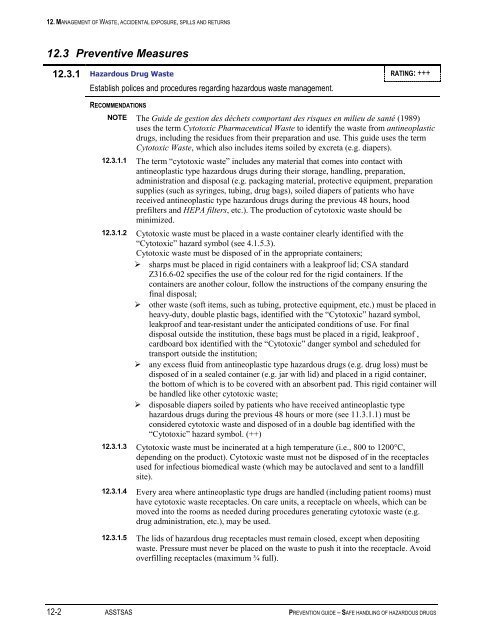Prevention Guide - Safe Handling of Hazardous Drugs - Irsst
Prevention Guide - Safe Handling of Hazardous Drugs - Irsst
Prevention Guide - Safe Handling of Hazardous Drugs - Irsst
You also want an ePaper? Increase the reach of your titles
YUMPU automatically turns print PDFs into web optimized ePapers that Google loves.
12. MANAGEMENT OF WASTE, ACCIDENTAL EXPOSURE, SPILLS AND RETURNS<br />
12.3 Preventive Measures<br />
12.3.1 <strong>Hazardous</strong> Drug Waste RATING: +++<br />
Establish polices and procedures regarding hazardous waste management.<br />
RECOMMENDATIONS<br />
NOTE The <strong>Guide</strong> de gestion des déchets comportant des risques en milieu de santé (1989)<br />
uses the term Cytotoxic Pharmaceutical Waste to identify the waste from antineoplastic<br />
drugs, including the residues from their preparation and use. This guide uses the term<br />
Cytotoxic Waste, which also includes items soiled by excreta (e.g. diapers).<br />
12.3.1.1 The term “cytotoxic waste” includes any material that comes into contact with<br />
antineoplastic type hazardous drugs during their storage, handling, preparation,<br />
administration and disposal (e.g. packaging material, protective equipment, preparation<br />
supplies (such as syringes, tubing, drug bags), soiled diapers <strong>of</strong> patients who have<br />
received antineoplastic type hazardous drugs during the previous 48 hours, hood<br />
prefilters and HEPA filters, etc.). The production <strong>of</strong> cytotoxic waste should be<br />
minimized.<br />
12.3.1.2 Cytotoxic waste must be placed in a waste container clearly identified with the<br />
“Cytotoxic” hazard symbol (see 4.1.5.3).<br />
Cytotoxic waste must be disposed <strong>of</strong> in the appropriate containers;<br />
‣ sharps must be placed in rigid containers with a leakpro<strong>of</strong> lid; CSA standard<br />
Z316.6-02 specifies the use <strong>of</strong> the colour red for the rigid containers. If the<br />
containers are another colour, follow the instructions <strong>of</strong> the company ensuring the<br />
final disposal;<br />
‣ other waste (s<strong>of</strong>t items, such as tubing, protective equipment, etc.) must be placed in<br />
heavy-duty, double plastic bags, identified with the “Cytotoxic” hazard symbol,<br />
leakpro<strong>of</strong> and tear-resistant under the anticipated conditions <strong>of</strong> use. For final<br />
disposal outside the institution, these bags must be placed in a rigid, leakpro<strong>of</strong> ,<br />
cardboard box identified with the “Cytotoxic” danger symbol and scheduled for<br />
transport outside the institution;<br />
‣ any excess fluid from antineoplastic type hazardous drugs (e.g. drug loss) must be<br />
disposed <strong>of</strong> in a sealed container (e.g. jar with lid) and placed in a rigid container,<br />
the bottom <strong>of</strong> which is to be covered with an absorbent pad. This rigid container will<br />
be handled like other cytotoxic waste;<br />
‣ disposable diapers soiled by patients who have received antineoplastic type<br />
hazardous drugs during the previous 48 hours or more (see 11.3.1.1) must be<br />
considered cytotoxic waste and disposed <strong>of</strong> in a double bag identified with the<br />
“Cytotoxic” hazard symbol. (++)<br />
12.3.1.3 Cytotoxic waste must be incinerated at a high temperature (i.e., 800 to 1200°C,<br />
depending on the product). Cytotoxic waste must not be disposed <strong>of</strong> in the receptacles<br />
used for infectious biomedical waste (which may be autoclaved and sent to a landfill<br />
site).<br />
12.3.1.4 Every area where antineoplastic type drugs are handled (including patient rooms) must<br />
have cytotoxic waste receptacles. On care units, a receptacle on wheels, which can be<br />
moved into the rooms as needed during procedures generating cytotoxic waste (e.g.<br />
drug administration, etc.), may be used.<br />
12.3.1.5 The lids <strong>of</strong> hazardous drug receptacles must remain closed, except when depositing<br />
waste. Pressure must never be placed on the waste to push it into the receptacle. Avoid<br />
overfilling receptacles (maximum ¾ full).<br />
12-2 ASSTSAS PREVENTION GUIDE – SAFE HANDLING OF HAZARDOUS DRUGS

















